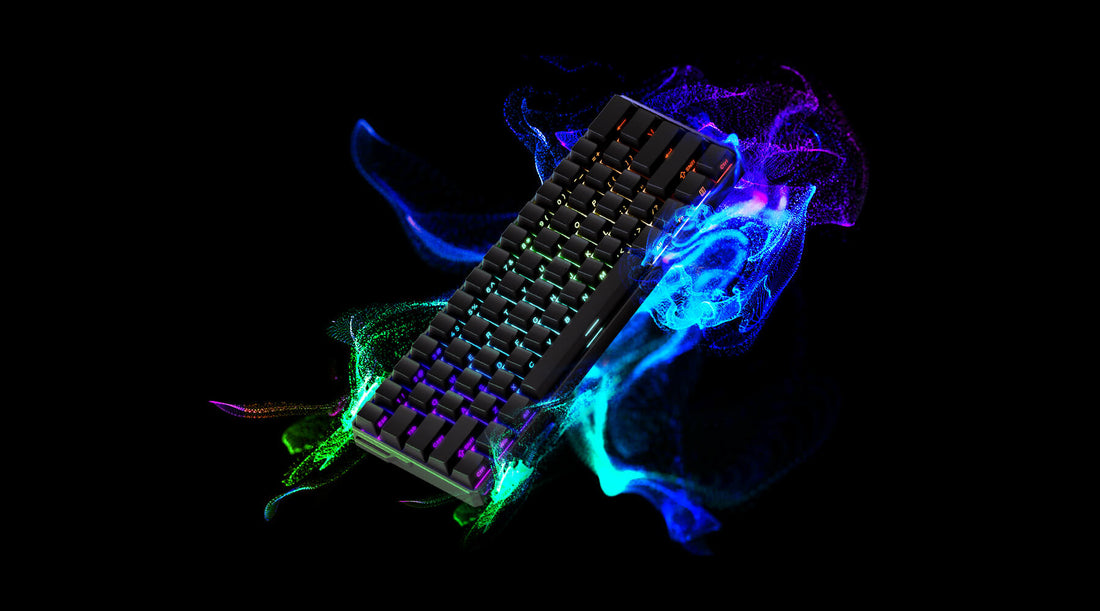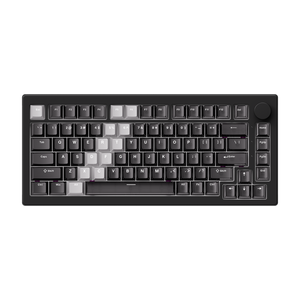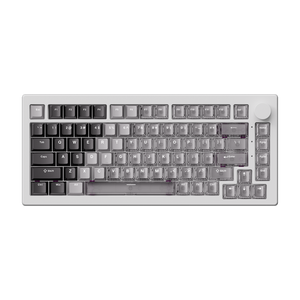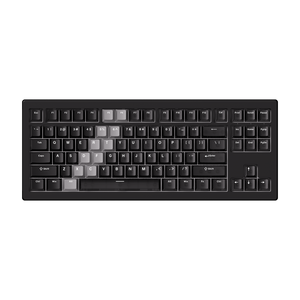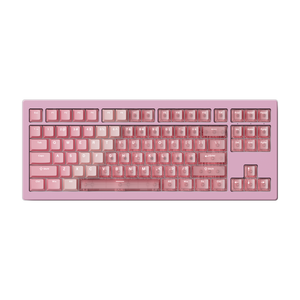When using a keyboard, have you ever wondered why the keys are arranged in QWERTY order rather than alphabetically? This arrangement was adopted from the typewriter keyboard in the 1870s and has a history spanning over 100 years.
What is the QWERTY keyboard layout?
The QWERTY layout is a widely used standard keyboard for typewriters and computers based on the Latin alphabet. It is frequently used on English and other language-specific keyboards . The name "QWERTY" comes from the arrangement of the first six letter keys from left to right: Q, W, E, R, T, Y.
Who invented the QWERTY keyboard layout?
The inventor of the QWERTY keyboard layout was the American Christopher Latham Sholes.
In 1868, Sholes received a patent for his typewriter model and the rights to market it. A few years later, he developed the practical form of the modern typewriter and standardized the keyboard layout for the first time – the "QWERTY" format.
Why QWERTY instead of ABCD?
1. The invention of the typewriter – ABCD
As early as 1714, countries such as Great Britain, the USA, France, Italy, and Switzerland developed various typewriter models, most of which featured an alphabetical keyboard layout. However, due to the inefficient mechanical design of these early typewriters, typing was extremely slow—often even slower than handwriting.
2. The need for a new layout – QWERTY
To solve the problem of keyboard blockage, Christopher Latham Sholes placed the most frequently used letters as far apart as possible. This deliberately slowed the typing speed to avoid mechanical blockages.
3. Market breakthrough – The influence of the Remington Company
In 1873, Sholes sold the design to the Remington Company.
On July 25, 1888, Remington held a nationwide typing contest in Cincinnati, USA. A participant who used the QWERTY layout with the "touch typing" method won the contest and a prize of $500. This brought widespread popularity to the QWERTY layout.
In addition, Remington opened a school to provide free training for typists. Graduates committed to working at private business schools, universities, and church youth organizations after completing their training.
Over time, the American market adapted to the QWERTY keyboard layout, making it the dominant standard in the industry.

Advantages of using QWERTY keyboards
1. Easy to learn and widely used
QWERTY keyboards are used worldwide on computers, smartphones, and other electronic devices. Their widespread use allows users to quickly adapt to different devices without having to learn a new keyboard layout.
2. Excellent compatibility
Due to its long history and widespread acceptance, the QWERTY layout has become the standard for software and operating systems. Users don't have to worry about compatibility issues between the keyboard and different programs.
Challenges of using QWERTY keyboards
There are discussions about the efficiency and ergonomic problems of the QWERTY layout.
1. Lack of ergonomic design
The QWERTY layout does not take into account the different lengths and thicknesses of human fingers, which can cause discomfort when typing.
Additionally, the workload falls primarily on the right hand, which processes approximately 57% of input, while the left hand only handles 43%. This causes the right hand to fatigue more quickly during longer typing sessions, reducing efficiency and compromising the overall user experience.
2. Inefficient letter placement
Frequently used letters like E, T, and A are located at the edge of the keyboard. This arrangement requires larger finger movements, forcing users to stretch their fingers further to reach these keys. In the long run, this can lead to increased finger fatigue and make it difficult to improve typing speed.
Variants of the QWERTY keyboard layout
1. ANSI QWERTY layout
This is the most widely used QWERTY layout, also known as the ANSI layout. It is the most common keyboard layout worldwide.
Widely distributed in: the USA, Canada, Australia, the Netherlands, and many Asian and Middle Eastern countries.
2. ISO QWERTY layout
The main difference between the ISO and ANSI layouts is the shape of the Enter key and the placement of some special keys. In the ISO layout, the Enter key is inverted and L-shaped.
Distributed in: most European countries and South America.
| feature | ANSI | ISO |
| Enter key shape | Wide, horizontal key | Inverted L-shape, occupies two rows |
| Backslash key | Above the Enter key | Left of the Enter key |
| Left Shift key | Same size as the right Shift key | 50% of the size of the right Shift key, same dimension as the Ctrl key |
| Right Alt key | Identical to the left Alt key | Replaced by an Alt Gr key |
3. QWERTZ layout

The name comes from the first six letters in the top row of letters: Q, W, E, R, T and Z. Compared to the standard QWERTY keyboard, the QWERTZ layout swaps the letters “Y” and “Z”.
Distributed in: Germany, Austria, Switzerland, Hungary and the Czech Republic.
| feature | QWERTY | QWERTY |
| Main layout | Widely used in German-speaking countries | Common in English-speaking countries |
| Z/Y swap | Z in the first row of letters | Y in the first row of letters |
| German characters | Contains Ä, Ö, Ü, ß | Not integrated |
| Special characters | Same, but easier access to € | Shift + 2 for @, Shift + 3 for # |
| AltGr key usage | More commonly used for regional symbols | For additional symbols |
| punctuation | Same, but the ? key may be different | Standard punctuation |
| Language support | German and Central European languages | English and Latin-based languages |
4. AZERTY layout

The AZERTY keyboard is a French typewriter and computer keyboard layout designed by Claude Marsan in 1976. The first six letters in the first row are A, Z, E, R, T, and Y. The layout was specifically adapted to the linguistic peculiarities and writing habits of French.
Mainly used in: France, for French text input.
| feature | AZERTY | QWERTY |
| Origin | France | United States |
| Main use | French-speaking countries | English-speaking countries |
| Upper row of letters | AZERTY | QWERTY |
| Special characters | Direct access to accented letters (é, è, à) | Limited, requires alt codes or special key combinations |
| punctuation | Period (.) requires the Shift key, while semicolon and other characters are directly accessible. | Period (.), comma (,) and other punctuation marks are accessible without the Shift key. |
5. Nordic QWERTY layout
The Nordic QWERTY layout retains most of the elements of the classic QWERTY layout, but adds Scandinavian letters (Å, Ä, Ö, Æ, Ø).
Distributed in: Denmark, Norway, Sweden, Finland and Iceland.
| feature | Nordic QWERTY | QWERTY (ANSI) |
| Additional letters | Å, Ä, Ö (Swedish/Finnish), Æ, Ø, Å (Danish/Norwegian) | No |
| Enter key | L-shaped (larger) | Rectangular |
| Special characters | Some symbols such as @, „ and £ are repositioned | standard |
| <> symbols | Dedicated key next to Shift | Shift + , and . |
| Currency symbol | € and local currencies (kr) included | $ |
| Accent support | Supports Scandinavian diacritics | Minimal |
6. Spanish QWERTY layout
The Spanish QWERTY layout includes additional special characters such as Ñ, ¡, and ¿, as well as special keys for accented vowels. The placement of some punctuation marks and symbols also differs.
Distributed in: Spain and Latin America.
| feature | Spanish QWERTY | QWERTY (ANSI) |
| Additional letter | Ñ key added | No |
| Enter key | L-shaped (larger) | Rectangular |
| Special characters | ¡ and ¿ contain | Standard placement |
| accent marks | ´ key for vowels with accents (á, é, í, ó, ú) | No special button |
| @-Symbol | AltGr + 2 | Shift + 2 |
| " and ' | Often swapped or repositioned | Standard positions |
| Currency symbol | € included | $ |
| Tilde (~) | Requires AltGr | Shift + key |
| Backslash () | Moved next to Shift | About Enter |
7. Japanese JIS layout

The JIS (Japanese Industrial Standard) keyboard includes not only Latin letters but also Hiragana and Katakana characters. There's also an additional key for switching between input modes (Romaji, Kana, Kanji).
Distributed in: Japan.
There are many other variations of the QWERTY keyboard, such as the Russian JCUKEN layout and the Arabic QWERTY layout. These variations were developed to adapt to the linguistic habits and user needs of different countries and regions.
Other alternative QWERTY variants
1. Dvorak keyboard
The Dvorak keyboard arranges keys based on frequency of use. Frequently used letters are in the middle row, while consonants and vowels are staggered.
This design allows for smoother and more balanced typing, improving efficiency and comfort.
2. Colemak keyboard
Colemak was developed as an optimized version of QWERTY. It maintains the positions of frequently used keyboard shortcuts and punctuation marks while rearranging certain letters.
This adjustment increases typing comfort and efficiency, providing a more pleasant input experience.
Conclusion
Despite alternative layouts such as Dvorak and Colemak, the QWERTY keyboard layout remains the dominant standard worldwide.
Different countries have developed customized QWERTY variants to support their languages, add special characters, and modify key placement. Each keyboard layout has its own advantages and disadvantages. Ultimately, we can choose the layout that best suits our individual preferences and needs.

